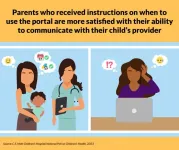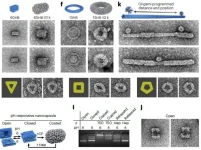(Press-News.org) Research Highlights:
An analysis of more than two million adults in the U.S. found that present day heart failure risk was higher among Black adults who lived in zip codes historically impacted by redlining compared to Black adults living in non-redlined areas.
Redlining did not have the same impact on heart failure risk among white adults living in historically redlined zip codes.
Among Black adults living in historically redlined communities, approximately half of the excess risk of heart failure appeared to be explained by higher levels of socioeconomic distress.
Embargoed until 1 p.m. CT/2 p.m. ET Monday, July 17, 2023
DALLAS, July 17, 2023 — The risk of heart failure in the present day was higher among Black adults who lived in U.S. zip codes historically impacted by redlining, according to research published today in the American Heart Association’s flagship, peer-reviewed journal Circulation. The analysis, published as part of the journal’s “Disparities in Cardiovascular Medicine Special Issue,” included more than 2.3 million adults from 2014-2019 who lived in U.S. communities with varying degrees of redlining, which began in the mid-1930s.
In 1933, the Home Owners’ Loan Corporation, a government agency created as part of President Roosevelt’s New Deal, began sponsoring low-interest mortgage loans to help people recover from the financial crisis of the Great Depression. In a process called “redlining,” the HOLC developed a color-coding system for neighborhoods across the country based on “risk for investment” criteria; it deemed red areas, which were largely Black communities, “too risky” to insure mortgages. The residents who lived in these neighborhoods were denied home loans, which lowered tax revenues in these communities and reduced investment in schools and government programs and services. This created numerous inequities for residents for multiple generations despite the practice being outlawed by the Fair Housing Act of 1968.
Previous research has found that communities exposed to redlining had higher rates of stroke, as well as increased risk of hypertension, Type 2 diabetes and early mortality due to heart disease. Heart failure is a progressive condition in which the heart is unable to pump enough blood to the body either due to the heart muscle stiffening or from it losing pumping strength. According to the American Heart Association’s 2023 Statistical Update, heart failure affects 6.7 million people in the U.S. and disproportionately impacts Black adults.
“Although discriminatory housing policies were effectively outlawed nearly a half-century ago, the relationship between historic redlining practices and people’s health today gives us unique insight into how historical policies may still be exerting their effects on the health of many communities,” said study co-senior author Shreya Rao, M.D., M.P.H., a cardiologist and assistant professor in the department of internal medicine at the University of Texas Health Science Center at San Antonio and University Hospital, both in San Antonio, Texas.
The researchers identified nearly 2.4 million adults in the Medicare Beneficiary Summary Files between 2014 and 2019 with linked residential zip codes. Study participants were 55.4% female and had a mean age of 71 years; 801,452 of participants self-identified as Black adults, and nearly 1.6 million participants self-identified as non-Hispanic white adults. Individuals of other races were excluded due to the low numbers available within the Medicare data. Participants were excluded from the analysis if they had a history of heart failure or heart attack in the preceding two years, had fewer than two years of Medicare coverage before the study start date or were younger than the age of 40.
The researchers mapped historical redlining maps onto modern day maps of 1,044 zip codes in the U.S. and sorted them into four groups ranging from zip codes that had the least amount of area impacted by redlining to zip codes with the most areas exposed to redlining.
“Ultimately, we were most interested in assessing the difference in risk of heart failure between individuals from communities with the highest level of exposure to redlining and individuals from other communities,” said first author Amgad Mentias, M.D., M.S., an interventional cardiology fellow at Cleveland Clinic in Cleveland, Ohio.
The researchers assessed the association between living in higher proportions of redlined zip codes and heart failure risk. They conducted separate analyses for Black and white adults and additional variables were considered, such as social determinants of health, which were determined at the zip-code level with Social Deprivation Index scores collected in the American Community Survey from 2011-2015. The Social Deprivation Index is a composite measure based on seven demographic characteristics collected in the American Community Survey, including poverty rate, education level, employment, access to transportation, household characteristics (single-parent households), percentage of households that rent rather than own housing, and percentage of households that are overcrowded. Heart failure was identified as hospitalization with a primary diagnosis of heart failure. Although most adults qualify for Medicare at 65 years old, the cohort also included adults younger than 65 who qualified for Medicaid due to disability.
The analysis found:
Black adults living in zip codes with the highest proportion of redlining had an 8% higher risk of developing heart failure compared to Black adults living in communities with low levels of redlining.
In contrast, white adults living in zip codes with the highest proportion of redlining did not have an increased risk of heart failure.
About half of the excess risk of heart failure among Black adults living in redlined communities was explained by higher levels of socioeconomic distress (determined by Social Deprivation Index scores) in those redlined communities.
The risk of heart failure was highest in Black adults living in redlined communities that had high scores on the Social Deprivation Index.
“These findings show us the harm that discriminatory and racist housing policies have had on generations of Black adults and suggest the long-term impact of such policies on cardiovascular health disparities,” said senior author Ambarish Pandey, M.D., M.S., a cardiologist and assistant professor in the department of internal medicine at the University of Texas Southwestern Medical Center in Dallas. “A reparative approach may be needed on the part of federal, state and local governments to intervene and drive investment in redlined communities.”
The findings also highlight the pivotal role housing plays as a social determinant of health, Pandey noted. “Aggressive enforcement of anti-discrimination laws in housing, and support for and pathways to homeownership for Black families are needed in order to begin to achieve equity in health, ” he said.
The study’s limitations include that redlining is just one facet of the impact of discrimination in the U.S. Redlining does not, alone, capture the full contribution of systemic racism on health today, the authors noted.
“Decades of discriminatory housing policies have left a lasting imprint on the cardiovascular health of Black communities. This careful and systematic analysis underscores the higher heart failure risk faced by Black adults residing in historically redlined areas, and provides evidence that social determinants of health, such as poverty, education, and access to healthy food, drive this risk,” said the American Heart Association’s Chief Clinical Science Officer Mitchell Elkind, M.D., M.S., FAHA, FAAN. “The study serves as a stark reminder of the ongoing impact of structural racism and emphasizes the urgent need for restorative actions and targeted investments to promote health equity.”
Co-authors are Mahasin S. Mujahid, Ph.D., FAHA; Andrew Sumarsono, M.D.; Robert K. Nelson, Ph.D.; Justin M. Madron, Ph.D.; Tiffany M. Powell-Wiley, M.D., M.P.H., FAHA; Utibe R. Essien, M.D., M.P.H.; Neil Keshvani, M.D.; Saket Girotra, M.D., S.M.; Alanna A. Morris, M.D., M.Sc., FAHA; Mario Sims, Ph.D., FAHA; Quinn Capers IV, M.D.; Clyde Yancy, M.D., M.Sc., FAHA; Milind Desai, M.D., M.B.A., FAHA; and Venu Menon, M.D., FAHA. Authors’ disclosures are listed in the manuscript.
The study was funded by the Haslam Family, Bailey Family and Khouri Family to the Cleveland Clinic, as well as the National Institute on Aging and the National Institute on Minority Health and Disparities, both of which are divisions of the National Institutes of Health.
The Disparities in Cardiovascular Medicine Special Issue of Circulation also includes a separate study examining historical neighborhood redlining and cardiovascular risk in patients with chronic kidney disease. In this study, researchers at Case Western Reserve University analyzed data for 1,720 participants enrolled in the Chronic Renal Insufficiency Cohort in 2003-2008. The analysis found that people with mild to moderate chronic kidney disease who lived in historically redlined neighborhoods had a two-fold higher risk of developing heart failure, independent of major risk factors for cardiovascular disease.
Additional research publishing in the special issue includes:
Historical Neighborhood Redlining and Cardiovascular Risk in Patients with Chronic Kidney Disease; Al-Kindi et al.
Associations between Maternal Sociodemographics and Hospital Mortality in Newborns with Prenatally Diagnosed Hypoplastic Left Heart Syndrome; Lopez et al.
Racial Disparities in Exposure to Ambient Air Pollution During Pregnancy and Prevalence of Congenital Heart Defects; Arogbokun Knutson et al.
Arrhythmia and Survival Outcomes among Black and White Patients with a Primary Prevention Defibrillator; Goldenberg et al.
Racial differences in quality of life in patients with heart failure treated with sodium-glucose cotransporter 2 inhibitors: A patient-level meta-analysis of the CHIEF-HF, DEFINE-HF, and PRESERVED-HF trials; Lanfear et al.
Race-based differences in ST elevation myocardial infarction (STEMI) process metrics and mortality from 2015-2021: an analysis of 178,062 patients from the American Heart Association Get With The Guidelines-Coronary Artery Disease (GWTG-CAD) Registry; Goyal et al.
Socioeconomic disparities and mediators for recurrent atherosclerotic cardiovascular disease events after a first myocardial infarction; Ohm et al.
Statements and conclusions of studies published in the American Heart Association’s scientific journals are solely those of the study authors and do not necessarily reflect the Association’s policy or position. The Association makes no representation or guarantee as to their accuracy or reliability. The Association receives funding primarily from individuals; foundations and corporations (including pharmaceutical, device manufacturers and other companies) also make donations and fund specific Association programs and events. The Association has strict policies to prevent these relationships from influencing the science content. Revenues from pharmaceutical and biotech companies, device manufacturers and health insurance providers and the Association’s overall financial information are available here.
Additional Resources:
Multimedia is available on right column of release link https://newsroom.heart.org/news/redlining-linked-to-higher-heart-failure-risk-among-black-adults-in-u-s?preview=298e1988abf3c097c8219ccc1529598a
After July 17, 2023, view the manuscript online.
AHA news release: Structural racism: Communities with higher redlining scores had higher rates of stroke (March 2021)
AHA presidential advisory: Call to Action: Structural Racism as a Fundamental Driver of Health Disparities (Nov. 2020)
Follow AHA/ASA news on Twitter @HeartNews
Follow news from the AHA’s flagship journal Circulation @CircAHA
About the American Heart Association
The American Heart Association is a relentless force for a world of longer, healthier lives. We are dedicated to ensuring equitable health in all communities. Through collaboration with numerous organizations, and powered by millions of volunteers, we fund innovative research, advocate for the public’s health and share lifesaving resources. The Dallas-based organization has been a leading source of health information for nearly a century. Connect with us on heart.org, Facebook, Twitter or by calling 1-800-AHA-USA1.
###
END
Redlining linked to higher heart failure risk among Black adults in US
Black adults living in areas historically affected by discriminatory housing practices had higher heart failure risk, according to new study published in Circulation journal
2023-07-17
ELSE PRESS RELEASES FROM THIS DATE:
Racial disparities discovered in patients with cardiac devices
2023-07-17
Black patients with implantable cardioverter defibrillators (ICDs) have a significantly higher burden of disease than white patients with the same device, according to a new study from University of Rochester Medical Center (URMC) cardiology researchers. Analyzing data from clinical trials conducted over a 20-year period by the Clinical Cardiovascular Research Center (CCRC) at URMC, investigators concluded that not only did Black patients with ICDs tend to be significantly younger than white patients, but they also had a higher ...
SwRI team identifies giant swirling waves at the edge of Jupiter’s magnetosphere
2023-07-17
SAN ANTONIO — July 17, 2023 —A team led by Southwest Research Institute (SwRI) and The University of Texas at San Antonio (UTSA) has found that NASA’s Juno spacecraft orbiting Jupiter frequently encounters giant swirling waves at the boundary between the solar wind and Jupiter’s magnetosphere. The waves are an important process for transferring energy and mass from the solar wind, a stream of charged particles emitted by the Sun, to planetary space environments.
Jake Montgomery, a doctoral student in the joint space physics program ...
Immune cells in single file
2023-07-17
The cells of the immune system circulate mainly in the blood and migrate into the body's tissues after an inflammation. Some types of immune cells, however, are permanently located in the tissues, where they come together to form three-dimensional networks.
How do these networks form and how are they maintained? For the long-lived macrophages (phagocytes), the answer is already known: They settle in so-called niches. These are environments of connective tissue cells that supply the macrophages with nutrients and keep them ...
New research shows babies’ immunological weak spot and strength
2023-07-17
NEW YORK, NY--A pair of new studies led by researchers at Columbia University explains why babies get so many common respiratory infections and identifies a specialized cluster of immune cells found only in babies that help them better cope with new pathogens.
“We know little about how the immune system develops throughout life, and most of what we know about immune system development in children comes from animal studies,” says Donna Farber, PhD, an expert in immune system development at Columbia University ...
National Poll: Less than half of parents utilize patient portal benefits for their children
2023-07-17
ANN ARBOR, Mich. – For many busy families, online access to a child’s health provider for medical advice, health records or prescription refills is likely a convenient option.
Yet, only 43% of parents have set their child up for a patient portal – an online tool allowing communication between patients and medical providers – and others may not be optimizing portal use, suggests the University of Michigan Health C.S. Mott Children’s Hospital National Poll on Children’s Health.
“Patient portals offer a wide range of benefits, including decreasing unnecessary hassles for providers and patients and improving access to both the medical ...
The missing Americans: Unprecedented US mortality far exceeds other wealthy nations
2023-07-17
FOR IMMEDIATE RELEASE
Monday, July 17, 2023
Contact:
Jillian McKoy, jpmckoy@bu.edu
Michael Saunders, msaunder@bu.edu
##
The Missing Americans: Unprecedented US Mortality Far Exceeds Other Wealthy Nations
A new study found that more than one million US deaths a year—including many young and working-age adults—could be avoided if the US had mortality rates similar to its peer nations.
In 2021, 1.1 million deaths would have been averted ...
Addressing the future challenges of global surface water quality
2023-07-17
As the world's population continues to grow, ensuring access to clean and safe water has become an increasingly important concern, yet little is known about how surface water quality will change in the future. Recent scientific research has shed light on the potential challenges that surface water quality may face in the coming years, particularly in Sub-Saharan Africa. “While surface water quality is projected to improve in most developed countries, there is an important caveat: the outlook for the poorest nations is bleak”.
A recent study, published in Nature Water, has projected an increase in surface water pollution in Sub-Saharan Africa. These findings ...
Study finds how to reduce risk of kids playing with a found gun
2023-07-17
COLUMBUS, Ohio – In a lab at The Ohio State University masquerading as a playroom, pairs of kids ages 8 to 12 participating in a study found a variety of toys and games to play with – as well as a mysterious file cabinet.
Inside one of the drawers of the unlocked cabinet were two disabled 9-mm handguns.
As they played in the room, nearly all the children eventually found the guns. But some kids in the study were much more likely to tell an adult they found a gun, less likely to touch the gun, and were less reckless if they did touch it – and they were the kids who had watched a one-minute gun safety video a week earlier.
The study may be the ...
Trading sickness for health: Swapping brain cells points to new Huntington's therapies
2023-07-17
NNew research appearing in the journal Nature Biotechnology answers important questions about the viability of treatments that seek to replace diseased and aged cells in the central nervous system with healthy ones. Its findings have implications for a number of neurological and psychiatric disorders—including Huntington’s disease, amyotrophic lateral sclerosis (ALS), and schizophrenia—that have been linked to glia, a population of cells that support brain health and function.
“A broad variety of disorders we associate with neuronal loss now appear to be caused ...
Researchers craft ‘origami DNA’ to control virus assembly
2023-07-17
Griffith University researchers have played a key role in using DNA ‘origami’ templates to control the way viruses are assembled.
The global team behind the research, published in Nature Nanotechnology, developed a way to direct the assembly of virus capsids – the protein shell of viruses - at physiological conditions in a precise and programmable manner.
Dr Frank Sainsbury and Dr Donna McNeale from the Griffith Institute for Drug Discovery were part of the research team and said forcing viruses to assemble onto DNA folded into different shapes “like origami” was a question that this project answered.
“We achieved control over the virus protein ...
LAST 30 PRESS RELEASES:
Tracing the quick synthesis of an industrially important catalyst
New software sheds light on cancer’s hidden genetic networks
UT Health San Antonio awarded $3 million in CPRIT grants to bolster cancer research and prevention efforts in South Texas
Third symposium spotlights global challenge of new contaminants in China’s fight against pollution
From straw to soil harmony: International team reveals how biochar supercharges carbon-smart farming
Myeloma: How AI is redrawing the map of cancer care
Manhattan E. Charurat, Ph.D., MHS invested as the Homer and Martha Gudelsky Distinguished Professor in Medicine at the University of Maryland School of Medicine
Insilico Medicine’s Pharma.AI Q4 Winter Launch Recap: Revolutionizing drug discovery with cutting-edge AI innovations, accelerating the path to pharmaceutical superintelligence
Nanoplastics have diet-dependent impacts on digestive system health
Brain neuron death occurs throughout life and increases with age, a natural human protein drug may halt neuron death in Alzheimer’s disease
SPIE and CLP announce the recipients of the 2025 Advanced Photonics Young Innovator Award
Lessons from the Caldor Fire’s Christmas Valley ‘Miracle’
Ant societies rose by trading individual protection for collective power
Research reveals how ancient viral DNA shapes early embryonic development
A molecular gatekeeper that controls protein synthesis
New ‘cloaking device’ concept to shield sensitive tech from magnetic fields
Researchers show impact of mountain building and climate change on alpine biodiversity
Study models the transition from Neanderthals to modern humans in Europe
University of Phoenix College of Doctoral Studies releases white paper on AI-driven skilling to reduce burnout and restore worker autonomy
AIs fail at the game of visual “telephone”
The levers for a sustainable food system
Potential changes in US homelessness by ending federal support for housing first programs
Vulnerability of large language models to prompt injection when providing medical advice
Researchers develop new system for high-energy-density, long-life, multi-electron transfer bromine-based flow batteries
Ending federal support for housing first programs could increase U.S. homelessness by 5% in one year, new JAMA study finds
New research uncovers molecular ‘safety switch’ shielding cancers from immune attack
Bacteria resisting viral infection can still sink carbon to ocean floor
Younger biological age may increase depression risk in older women during COVID-19
Bharat Innovates 2026 National Basecamp Showcases India’s Most Promising Deep-Tech Ventures
Here’s what determines whether your income level rises or falls
[Press-News.org] Redlining linked to higher heart failure risk among Black adults in USBlack adults living in areas historically affected by discriminatory housing practices had higher heart failure risk, according to new study published in Circulation journal



